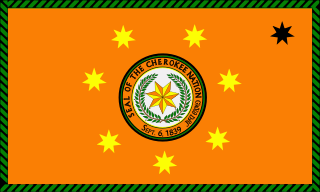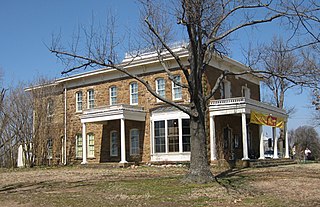
Muskogee County is a county located in the U.S. state of Oklahoma. As of the 2010 census, the population was 70,990. The county seat is Muskogee. The county and city were named for the Muscogee (Creek) Nation. The official spelling of the name was changed to Muskogee by the post office in 1900.
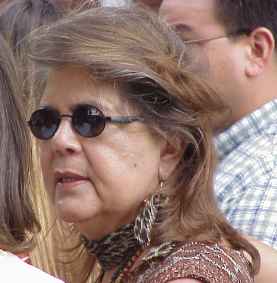
Wilma Pearl Mankiller was an activist, social worker, community developer and the first woman elected to serve as Principal Chief of the Cherokee Nation. Born in Tahlequah, Oklahoma, she lived on her family's allotment in Adair County, Oklahoma, until the age of 11, when her family relocated to San Francisco as part of a federal government program to urbanize Native Americans. After high school, she married a well-to-do Ecuadorian and raised two daughters. Inspired by the social and political movements of the 1960s, Mankiller became involved in the Occupation of Alcatraz and later participated in the land and compensation struggles with the Pit River Tribe. For five years in the early 1970s, she was employed as a social worker, focusing mainly on children's issues.

Bacone College, formerly Bacone Indian University, is a private four-year liberal arts college in Muskogee, Oklahoma, United States. Founded in 1880 as the Indian University by Almon C. Bacone, Bacone College is the oldest continuously operated institution of higher education in Oklahoma. The college has strong historic ties to various tribal nations, including the Cherokee Nation and the Muscogee (Creek) Nation, and also to the American Baptist Churches USA.

Acee Blue Eagle, also named Alex C. McIntosh, Chebon Ahbulah, and Lumhee Holot-Tee, was a Muscogee Creek-Pawnee-Wichita artist, educator, dancer, and Native American flute player.

hJoan Hill, also known as Che-se-quah, is a Muscogee Creek artist of Cherokee ancestry. She is one of the most awarded women artists in the Native American art world.
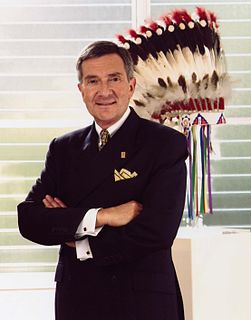
Walter Richard "Rick" West Jr. is the president and CEO of the Autry National Center in Los Angeles. He was the founding director of the Smithsonian National Museum of the American Indian, retiring from the position in 2007. He is also a citizen of the Cheyenne and Arapaho Tribes in Oklahoma and a Peace Chief of the Southern Cheyenne. His professional life has been devoted to serving the American Indian community on cultural, artistic, educational, legal and governmental issues.
The Five Moons are five Native American ballerinas from the U.S. state of Oklahoma who achieved international prominence during the 20th century. They are Yvonne Chouteau, Rosella Hightower, Moscelyne Larkin, and sisters Maria Tallchief and Marjorie Tallchief. Five Moons (2007) is the name of a bronze sculpture installation in Tulsa, Oklahoma, that portrays the five ballerinas.

Martha Berry is a Cherokee beadwork artist, who has been highly influential in reviving traditional Cherokee and Southeastern beadwork, particularly techniques from the pre-Removal period. She has been recognized as a Cherokee National Treasure. Her work is shown in museums around the United States.
The Oklahoma Music Hall of Fame, located in Muskogee, Oklahoma, honors Oklahoma musicians for their lifetime achievements in music. The induction ceremony and concert are held each year in Muskogee. Since its establishment in 1997, the Hall of Fame has inducted more than 37 individuals or groups, produced more than 7 concerts, and renovated in part the facility that will educate Oklahomans for generations about those innovators and industry icons from Oklahoma.
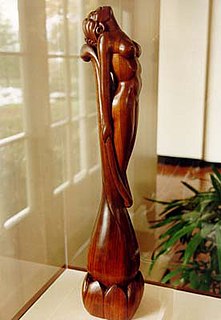
Willard Stone was an American artist best known for his wood sculptures carved in a flowing Art Deco style
Cecil Dick, or Degadoga (1915–1992) was a well-known Cherokee artist often referred to as "the Father of Cherokee Traditional Art". Cecil, born near Rose Prairie, Oklahoma, was one of the pioneers of 20th-century, flat-style painting among Eastern Woodland tribes in Oklahoma. He was enrolled in the Cherokee Nation and the United Keetoowah Band of Cherokee Indians.
Walter Richard "Dick" West Sr. (1912–1996) was a Southern Cheyenne painter, sculptor, and educator from Oklahoma and an honored member of the Cheyenne and Arapaho Tribes.
The Bacone style or Bacone school of painting, drawing, and printmaking is a Native American Flatstyle art movement, primarily from the mid-20th century in Eastern Oklahoma. This art movement bridges historical, tribally-specific pictorial painting and carving practices towards an intertribal Modernist style of easel painting.
Sharon Irla is an award-winning, Cherokee artist, enrolled in the Cherokee Nation. A self-taught artist, Irla began entering competitive art shows in 2003. Her collective body of works span the fields of painting, murals, graphics, photography, and custom picture frames with Southeastern Woodlands / Mississippian motifs. The majority of her awarded works are oil-on-canvas portraits of Cherokee women in both contemporary and historical settings.

Virginia Alice Stroud is a Cherokee-Muscogee Creek painter from Oklahoma. She is an enrolled member of the United Keetoowah Band of Cherokee Indians.

Ruthe Blalock Jones is a Delaware-Shawnee-Peoria painter and printmaker from Oklahoma.
Dana Tiger is a Muscogee Creek-Seminole and Cherokee artist from Oklahoma. Her artwork focuses on portrayals of strong women. She uses art as a medium for activism and raising awareness. Tiger was inducted into the Oklahoma Women's Hall of Fame in 2001.
David Emmett Williams was a Native American painter of Kiowa-Tonkawa/Kiowa-Apache heritage from Oklahoma. He studied with Dick West at Bacone College and won numerous national awards for his paintings. He painted in the flat-style painting technique that was taught at Bacone from the 1940s-1960s.

